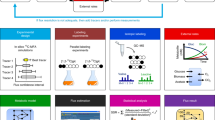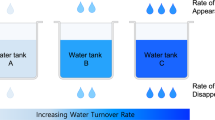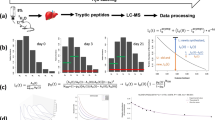Abstract
Stable isotope labeling by essential nutrients in cell culture (SILEC) was recently developed to generate isotopically labeled coenzyme A (CoA) and short-chain acyl-CoA thioesters. This was accomplished by modifying the widely used technique of stable isotope labeling by amino acids in cell culture to include [13C315N]-pantothenate (vitamin B5), a CoA precursor, instead of the isotopically labeled amino acids. The lack of a de novo pantothenate synthesis pathway allowed for efficient and near-complete labeling of the measured CoA species. This protocol provides a step-by-step approach for generating stable isotope-labeled short-chain acyl-CoA internal standards in mammalian and insect cells as well as instructions on how to use them in stable isotope dilution mass spectrometric-based analyses. Troubleshooting guidelines, as well as a list of unlabeled and labeled CoA species, are also included. This protocol represents a prototype for generating stable isotope internal standards from labeled essential nutrients such as pantothenate. The generation and use of SILEC standards takes approximately 2–3 weeks.
This is a preview of subscription content, access via your institution
Access options
Subscribe to this journal
Receive 12 print issues and online access
$259.00 per year
only $21.58 per issue
Buy this article
- Purchase on Springer Link
- Instant access to full article PDF
Prices may be subject to local taxes which are calculated during checkout







Similar content being viewed by others
References
Hsieh, Y. HPLC-MS/MS in drug metabolism and pharmacokinetic screening. Expert Opin. Drug Metab. Toxicol. 4, 93–101 (2008).
Brown, S.C., Kruppa, G. & Dasseux, J.L. Metabolomics applications of FT-ICR mass spectrometry. Mass Spectrom. Rev. 24, 223–231 (2005).
Hu, Q.Z. et al. The Orbitrap: a new mass spectrometer. J. Mass Spectrom. 40, 430–443 (2005).
Whalen, K., Gobey, J. & Janiszewski, J. A centralized approach to tandem mass spectrometry method development for high-throughput ADME screening. Rapid Commun. Mass Spectrom. 20, 1497–1503 (2006).
Taylor, C.F. et al. A systematic approach to modeling, capturing, and disseminating proteomics experimental data. Nat. Biotechnol. 21, 247–254 (2003).
Cox, J. et al. A practical guide to the MaxQuant computational platform for SILAC-based quantitative proteomics. Nat. Protoc. 4, 698–705 (2009).
Madalinski, G. et al. Direct introduction of biological samples into a LTQ-Orbitrap hybrid mass spectrometer as a tool for fast metabolome analysis. Anal. Chem. 80, 3291–3303 (2008).
Wu, C.C. & Yates, J.R. III . The application of mass spectrometry to membrane proteomics. Nat. Biotechnol. 21, 262–267 (2003).
Jemal, M. High-throughput quantitative bioanalysis by LC/MS/MS. Biomed. Chromatogr. 14, 422–429 (2000).
Remane, D., Wissenbach, D.K., Meyer, M.R. & Maurer, H.H. Systematic investigation of ion suppression and enhancement effects of fourteen stable-isotope-labeled internal standards by their native analogues using atmospheric-pressure chemical ionization and electrospray ionization and the relevance for multi-analyte liquid chromatographic/mass spectrometric procedures. Rapid Commun. Mass Spectrom. 24, 859–867 (2010).
Prakash, C., Shaffer, C.L. & Nedderman, A. Analytical strategies for identifying drug metabolites. Mass Spectrom. Rev. 26, 340–369 (2007).
Bonfiglio, R., King, R.C., Olah, T.V. & Merkle, K. The effects of sample preparation methods on the variability of the electrospray ionization response for model drug compounds. Rapid Commun. Mass Spectrom. 13, 1175–1185 (1999).
King, R., Bonfiglio, R., Fernandez-Metzler, C., Miller-Stein, C. & Olah, T. Mechanistic investigation of ionization suppression in electrospray ionization. J. Am. Soc. Mass Spectrom. 11, 942–950 (2000).
Matuszewski, B.K. Standard line slopes as a measure of a relative matrix effect in quantitative HPLC-MS bioanalysis. J. Chromatogr. B 830, 293–300 (2006).
Ciccimaro, E. & Blair, I.A. Stable-isotope dilution LC-MS for quantitative biomarker analysis. Bioanalysis 2, 311–341 (2010).
Bennett, B.D., Yuan, J., Kimball, E.H. & Rabinowitz, J.D. Absolute quantitation of intracellular metabolite concentrations by an isotope ratio-based approach. Nat. Protoc. 3, 1299–1311 (2008).
Ong, S.E. & Mann, M. A practical recipe for stable isotope labeling by amino acids in cell culture (SILAC). Nat. Protoc. 1, 2650–2660 (2006).
Basu, S.S., Mesaros, C., Gelhaus, S.L. & Blair, I.A. Stable isotope labeling by essential nutirents in cell culture for the preparation of labeled coenzyme A and its thioesters. Anal. Chem. 83, 1363–1369 (2011).
Ong, S.E. et al. Stable isotope labeling by amino acids in cell culture, SILAC, as a simple and accurate approach to expression proteomics. Mol. Cell. Proteomics 1, 376–386 (2002).
Yan, Y., Weaver, V.M. & Blair, I.A. Analysis of protein expression during oxidative stress in breast epithelial cells using a stable isotope labeled proteome internal standard. J. Proteome Res. 4, 2007–2014 (2005).
Shah, S.J., Yu, K.H., Sangar, V., Parry, S.I. & Blair, I.A. Identification and quantification of preterm birth biomarkers in human cervicovaginal fluid by liquid chromatography/tandem mass spectrometry. J. Proteome Res. 8, 2407–2417 (2009).
Rangiah, K. et al. Differential secreted proteome approach in murine model for candidate biomarker discovery in colon cancer. J. Proteome Res. 8, 5153–5164 (2009).
Geiger, T. et al. Use of stable isotope labeling by amino acids in cell culture as a spike-in standard in quantitative proteomics. Nat. Protoc. 6, 147–157 (2011).
Brass, E.P. Overview of coenzyme A metabolism and its role in cellular toxicity. Chem. Biol. Interact 90, 203–214 (1994).
Robishaw, J.D. & Neely, J.R. Coenzyme A metabolism. Am. J. Physiol. 248, E1–E9 (1985).
Li, L.O., Klett, E.L. & Coleman, R.A. Acyl-CoA synthesis, lipid metabolism and lipotoxicity. Biochim. Biophys. Acta 1801, 246–251 (2010).
Magnes, C., Sinner, F.M., Regittnig, W. & Pieber, T.R. LC/MS/MS method for quantitative determination of long-chain fatty acyl-CoAs. Anal. Chem. 77, 2889–2894 (2005).
Gao, L. et al. Simultaneous quantification of malonyl-CoA and several other short-chain acyl-CoAs in animal tissues by ion-pairing reversed-phase HPLC/MS. J. Chromatogr. B 853, 303–313 (2007).
MacDonald, M.J., Smith, A.D. III, Hasan, N.M., Sabat, G. & Fahien, L.A. Feasibility of pathways for transfer of acyl groups from mitochondria to the cytosol to form short chain acyl-CoAs in the pancreatic beta cell. J. Biol. Chem. 282, 30596–30606 (2007).
MacDonald, M.J. Synergistic potent insulin release by combinations of weak secretagogues in pancreatic islets and INS-1 cells. J. Biol. Chem. 282, 6043–6052 (2007).
Lowe, D.M. & Tubbs, P.K. Succinylation and inactivation of 3-hydroxy-3-methylglutaryl-CoA synthase by succinyl-CoA and its possible relevance to the control of ketogenesis. Biochem. J. 232, 37–42 (1985).
O'Donovan, D.J. et al. CoASH and CoASSG levels in lungs of hyperoxic rats as potential biomarkers of intramitochondrial oxidant stresses. Pediatr. Res. 51, 346–353 (2002).
Wong, Y.L., Smith, C.V., McMicken, H.W., Rogers, L.K. & Welty, S.E. Mitochondrial thiol status in the liver is altered by exposure to hyperoxia. Toxicol. Lett. 123, 179–193 (2001).
Feliz, B., Witt, D.R. & Harris, B.T. Propionic acidemia: a neuropathology case report and review of prior cases. Arch. Pathol. Lab. Med. 127, e325–e328 (2003).
Mitchell, G.A. et al. Hereditary and acquired diseases of acyl-coenzyme A metabolism. Mol. Genet. Metab. 94, 4–15 (2008).
Van Hove, J.L. et al. D, L-3-hydroxybutyrate treatment of multiple acyl-CoA dehydrogenase deficiency (MADD). Lancet 361, 1433–1435 (2003).
van Grunsven, E.G. et al. Peroxisomal D-hydroxyacyl-CoA dehydrogenase deficiency: resolution of the enzyme defect and its molecular basis in bifunctional protein deficiency. Proc. Natl. Acad. Sci. USA 95, 2128–2133 (1998).
van Maldegem, B.T., Wanders, R.J. & Wijburg, F.A. Clinical aspects of short-chain acyl-CoA dehydrogenase deficiency. J. Inherit. Metab. Dis. 33, 507–511 (2010).
Steghens, J.P., Flourie, F., Arab, K. & Collombel, C. Fast liquid chromatography-mass spectrometry glutathione measurement in whole blood: micromolar GSSG is a sample preparation artifact. J. Chromatogr. B Analyt. Technol. Biomed. Life Sci. 798, 343–349 (2003).
Blair, I.A. Endogenous glutathione adducts. Curr. Drug Metab. 7, 853–872 (2006).
Zhu, P., Oe, T. & Blair, I.A. Determination of cellular redox status by stable isotope dilution liquid chromatography/mass spectrometry analysis of glutathione and glutathione disulfide. Rapid. Commun. Mass Spectrom. 22, 432–440 (2008).
Hayashi, O. & Satoh, K. Determination of acetyl-CoA and malonyl-CoA in germinating rice seeds using the LC-MS/MS technique. Biosci. Biotechnol. Biochem. 70, 2676–2681 (2006).
Perera, M.A., Choi, S.Y., Wurtele, E.S. & Nikolau, B.J. Quantitative analysis of short-chain acyl-coenzymeAs in plant tissues by LC-MS-MS electrospray ionization method. J. Chromatogr. B 877, 482–488 (2009).
Dalluge, J.J. et al. Separation and identification of organic acid-coenzyme A thioesters using liquid chromatography/electrospray ionization-mass spectrometry. Anal. Bioanal. Chem. 374, 835–840 (2002).
Magnes, C. et al. Validated comprehensive analytical method for quantification of coenzyme A activated compounds in biological tissues by online solid-phase extraction LC/MS/MS. Anal. Chem. 80, 5736–5742 (2008).
Minkler, P.E., Kerner, J., Kasumov, T., Parland, W. & Hoppel, C.L. Quantification of malonyl-coenzyme A in tissue specimens by high-performance liquid chromatography/mass spectrometry. Anal. Biochem. 352, 24–32 (2006).
Park, J.W., Jung, W.S., Park, S.R., Park, B.C. & Yoon, Y.J. Analysis of intracellular short organic acid-coenzyme A esters from actinomycetes using liquid chromatography-electrospray ionization-mass spectrometry. J. Mass Spectrom. 42, 1136–1147 (2007).
Leonardi, R., Zhang, Y.M., Rock, C.O. & Jackowski, S. Coenzyme A: back in action. Prog. Lipid Res. 44, 125–153 (2005).
Kasuya, F., Oti, Y., Tatsuki, T. & Igarashi, K. Analysis of medium-chain acyl-coenzyme A esters in mouse tissues by liquid chromatography-electrospray ionization mass spectrometry. Anal. Biochem. 325, 196–205 (2004).
Minkler, P.E., Kerner, J., Ingalls, S.T. & Hoppel, C.L. Novel isolation procedure for short-, medium-, and long-chain acyl-coenzyme A esters from tissue. Anal. Biochem. 376, 275–276 (2008).
Zhang, G.F. et al. Catabolism of 4-hydroxyacids and 4-hydroxynonenal via 4-hydroxy-4-phosphoacyl-CoAs. J. Biol. Chem. 284, 33521–33534 (2009).
Haynes, C.A. et al. Quantitation of fatty acyl-coenzyme As in mammalian cells by liquid chromatography-electrospray ionization tandem mass spectrometry. J. Lipid Res. 49, 1113–1125 (2008).
Mauriala, T., Herzig, K.H., Heinonen, M., Idziak, J. & Auriola, S. Determination of long-chain fatty acid acyl-coenzyme A compounds using liquid chromatography-electrospray ionization tandem mass spectrometry. J. Chromatogr. B 808, 263–268 (2004).
Bennett, M.J. & Hale, D.E. Medium chain acyl-coenzyme A dehydrogenase deficiency. N. J. Med. 89, 675–678 (1992).
Boneh, A. et al. VLCAD deficiency: pitfalls in newborn screening and confirmation of diagnosis by mutation analysis. Mol. Genet. Metab. 88, 166–170 (2006).
Wood, J.C. et al. Diagnosis of very long chain acyl-dehydrogenase deficiency from an infant's newborn screening card. Pediatrics 108, E19 (2001).
Chang, S.H. & Wilken, D.R. Identity of a bovine liver nucleotide peptide with the unsymmetrical disulfied of coenzyme A and glutathione. J. Biol. Chem. 240, 3136–3139 (1965).
Kawaguchi, A., Yoshimura, T. & Okuda, S. A new method for the preparation of acyl-CoA thioesters. J. Biochem. 89, 337–339 (1981).
Olsen, J., Bjornsdottir, I., Tjornelund, J. & Honore, H.S. Chemical reactivity of the naproxen acyl glucuronide and the naproxen coenzyme A thioester towards bionucleophiles. J. Pharm. Biomed. Anal. 29, 7–15 (2002).
van Wyk, M. & Strauss, E. One-pot preparation of coenzyme A analogues via an improved chemo-enzymatic synthesis of pre-CoA thioester synthons. Chem. Commun. 398–400 (2007).
Cooper, S. Reappraisal of serum starvation, the restriction point, G0, and G1 phase arrest points. FASEB J. 17, 333–340 (2003).
Hasan, N.M., Adams, G.E. & Joiner, M.C. Effect of serum starvation on expression and phosphorylation of PKC-alpha and p53 in V79 cells: implications for cell death. Int. J. Cancer 80, 400–405 (1999).
Shin, J.S. et al. Serum starvation induces G1 arrest through suppression of Skp2-CDK2 and CDK4 in SK-OV-3 cells. Int. J. Oncol. 32, 435–439 (2008).
Cornille, E. et al. Enhancement of L-3-hydroxybutyryl-CoA dehydrogenase activity and circulating ketone body levels by pantethine. Relevance to dopaminergic injury. BMC Neurosci. 11, 51 (2010).
MacDonald, M.J. et al. Acetoacetate and beta-hydroxybutyrate in combination with other metabolites release insulin from INS-1 cells and provide clues about pathways in insulin secretion. Am. J. Physiol. Cell Physiol. 294, C442–C450 (2008).
Iwasaki, K. et al. Effects of antiprogestins on the rate of proliferation of breast cancer cells. Mol. Cell Biochem. 198, 141–149 (1999).
Cao, Z. et al. Effects of resin or charcoal treatment on fetal bovine serum and bovine calf serum. Endocr. Res. 34, 101–108 (2009).
Acknowledgements
The support of US National Institutes of Health grants U01ES016004, P30ES013508 and 5T32HL007439 is gratefully acknowledged.
Author information
Authors and Affiliations
Contributions
Both authors wrote the paper and designed the experiments. S.S.B. conducted the actual experiments.
Corresponding author
Ethics declarations
Competing interests
The authors declare no competing financial interests.
Supplementary information
Supplementary Table 1
Protonated molecule m/z values for endogenous and labeled CoA species. (PPT 153 kb)
Rights and permissions
About this article
Cite this article
Basu, S., Blair, I. SILEC: a protocol for generating and using isotopically labeled coenzyme A mass spectrometry standards. Nat Protoc 7, 1–11 (2012). https://doi.org/10.1038/nprot.2011.421
Published:
Issue Date:
DOI: https://doi.org/10.1038/nprot.2011.421
This article is cited by
-
Alteration in Cerebral Metabolism in a Rodent Model of Acute Sub-lethal Cyanide Poisoning
Journal of Medical Toxicology (2023)
-
PI3K drives the de novo synthesis of coenzyme A from vitamin B5
Nature (2022)
-
BCAA–BCKA axis regulates WAT browning through acetylation of PRDM16
Nature Metabolism (2022)
-
Fungal diversity notes 1036–1150: taxonomic and phylogenetic contributions on genera and species of fungal taxa
Fungal Diversity (2019)
-
Characterization of histone acylations links chromatin modifications with metabolism
Nature Communications (2017)
Comments
By submitting a comment you agree to abide by our Terms and Community Guidelines. If you find something abusive or that does not comply with our terms or guidelines please flag it as inappropriate.



